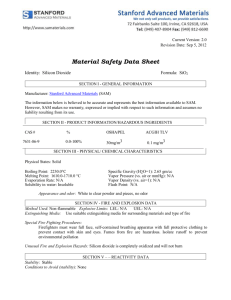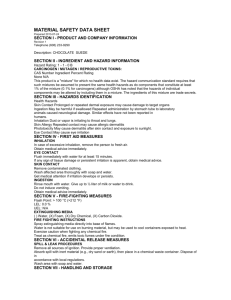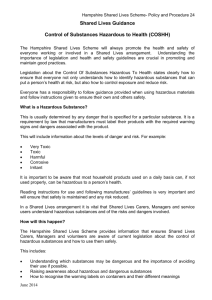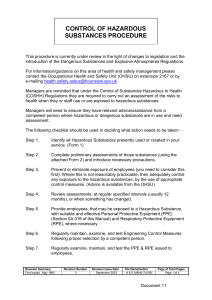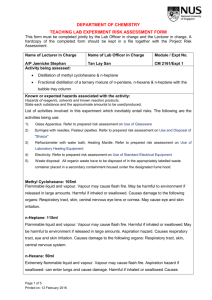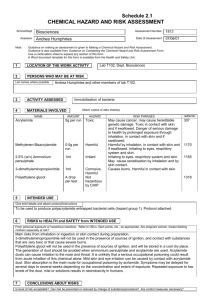C.O.S.H.H risk assessment
advertisement
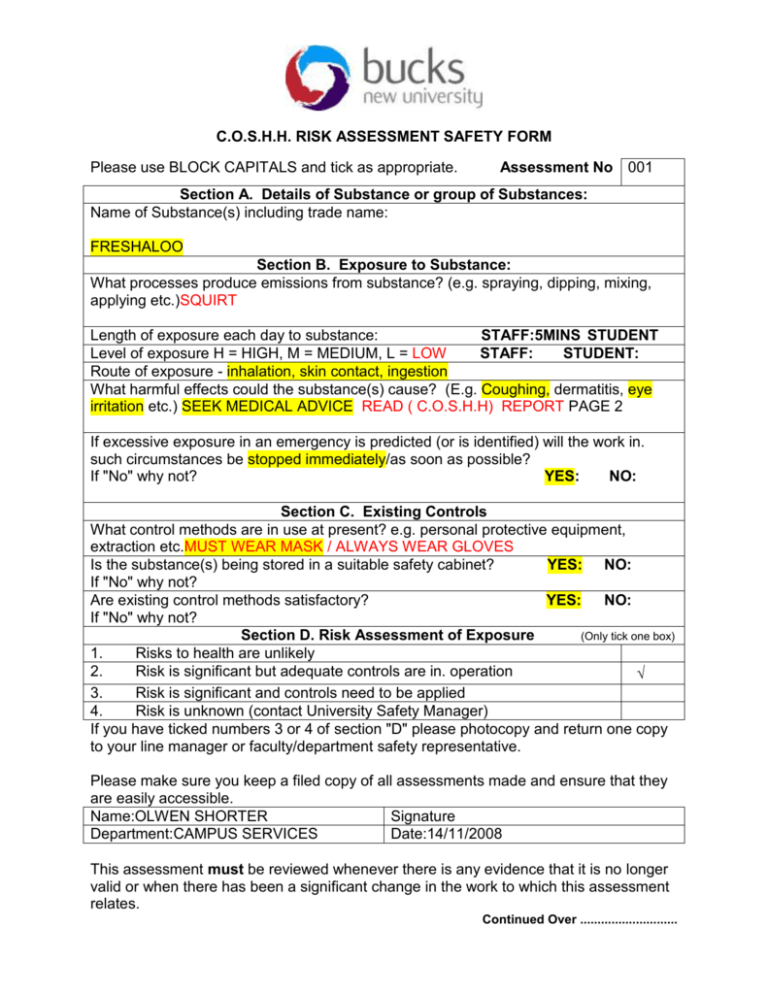
C.O.S.H.H. RISK ASSESSMENT SAFETY FORM Please use BLOCK CAPITALS and tick as appropriate. Assessment No 001 Section A. Details of Substance or group of Substances: Name of Substance(s) including trade name: FRESHALOO Section B. Exposure to Substance: What processes produce emissions from substance? (e.g. spraying, dipping, mixing, applying etc.)SQUIRT Length of exposure each day to substance: STAFF:5MINS STUDENT Level of exposure H = HIGH, M = MEDIUM, L = LOW STAFF: STUDENT: Route of exposure - inhalation, skin contact, ingestion What harmful effects could the substance(s) cause? (E.g. Coughing, dermatitis, eye irritation etc.) SEEK MEDICAL ADVICE READ ( C.O.S.H.H) REPORT PAGE 2 If excessive exposure in an emergency is predicted (or is identified) will the work in. such circumstances be stopped immediately/as soon as possible? If "No" why not? YES: NO: Section C. Existing Controls What control methods are in use at present? e.g. personal protective equipment, extraction etc.MUST WEAR MASK / ALWAYS WEAR GLOVES Is the substance(s) being stored in a suitable safety cabinet? YES: NO: If "No" why not? Are existing control methods satisfactory? YES: NO: If "No" why not? Section D. Risk Assessment of Exposure (Only tick one box) 1. Risks to health are unlikely 2. Risk is significant but adequate controls are in. operation √ 3. Risk is significant and controls need to be applied 4. Risk is unknown (contact University Safety Manager) If you have ticked numbers 3 or 4 of section "D" please photocopy and return one copy to your line manager or faculty/department safety representative. Please make sure you keep a filed copy of all assessments made and ensure that they are easily accessible. Name:OLWEN SHORTER Signature Department:CAMPUS SERVICES Date:14/11/2008 This assessment must be reviewed whenever there is any evidence that it is no longer valid or when there has been a significant change in the work to which this assessment relates. Continued Over ............................ If you have any requirements or comments please make them below: SKIN DRENCH AREA WITH WATER FOR 10/15 MINUTES AND IF IRRITATION IS APPARENT SEEK MEDICAL ATTENTION.IRRITANT/REDNESS WILL RESULT IF SLOW TO REACT./DO NOT DELAY. EYES IF EYE CONTACT RESULTS IRRIGATE IMMEDIATELY WITH AN EYEWASH FOR 10/15 MINUTES AND SEEK IMMEDIATE MEDICAL ATTENTION. SEVERE IRRITANT EFFECT COULD RESULT IF SLOW TO REACT. INGESTION WASH MOUTH WITH PLENTY OF WATER.DRINK WATER OR MILK TO DILUTE HAZARD AND SEEK IMMEDIATE MEDICAL ATTENTION SHOWING THIS DATA SHEET REACT QUICKLY.DO NOT INDUCE VOMITING DUE TO RISK OF ASPIRATION OF ACID VAPOURS. INHALATION REMOVE TO FRESH AIR AND KEEP WARM.SEEK MEDICAL ATTENTION IF SYMPTOMS PERSIST.MINOR RISK BY INHALATION. MEDICAL ADVICE CHEMICALS SHOULD NOT BE ALLOWED TO COME IN CONTACT WITH EYES OR CLOTHING.IF SO REACT QUICKLY TO ADDRESS THE HAZARD The purpose of this assessment is to enable a valid decision to be made about measures necessary to control substances hazardous to health arising from work. The Control of Substances Hazardous to Health Regulations 1999 (COSHH) require the university to assess the risks created by work in which a hazardous substance is used. Suppliers of substances hazardous to health are legally required to provide a "Safety Data Sheet". This will give you all the information required to make a COSHH risk assessment. Measures For Preventing or Controlling Exposure For Preventing Exposure: (1) elimination of the use of the substance; (2) substitution by a less hazardous substance or by the same substance in a less hazardous form. For Controlling Exposure: (1) totally enclosed process and handling systems; (2) plant or processes or systems of work which minimise generation of or suppress or contain, the hazardous dust, fume etc. and which limit the area of contamination in the event of spills and leaks; (3) partial enclosure, with local exhaust ventilation; (4) local exhaust ventilation; (5) sufficient general ventilation; (6) reduction of numbers of staff/students exposed and exclusion of non-essential access; (7) reduction in the period of exposure for staff/students; (8) regular cleaning of contamination from, or disinfecting of walls, surfaces etc; (9) provision of means for safe storage and disposal of substances hazardous to health; (10) suitable personal protective equipment; (11) prohibition of eating, drinking, smoking etc. in contaminated areas; (12) provision of adequate facilities for washing, changing, including arrangements for laundering contaminated clothing. If you have any problems with this risk assessment form, please contact the University Safety Manager (Mr T Everett. Ext: 3047)
